Sanjeevani Booti- A Magical Medicinal Herb from Ramayana

Sanjeevani Booti- A Magical Medicinal Herb from Ramayana
Today we are celebrating auspicious day of Rama Navami. The story of Lord Hanuman associated with Sanjeevani booti is one of interesting highlight of the Ramayana.
Sanjeevani means ‘to bring back to life’. The divya aushadhi (divine medicine) that was used to revive Lord Laxmana, brother of Lord Ram was subject of research from many days.
When Laxmana was shot by a poisonous arrow, Hanuman was entrusted with the task of finding 4 special herbs (Sanjeevani, Vishalyakarani, Sandhanakarani and Savarnyakarani) on mountain Dronagiri in the Himalayas. The most important of this herb, Sanjeevani is believed to bring the dead back to life.
Ramayana is having many references related to Ayurved but curiosity about this wonder herb is unparalleled.

This curiosity leads into hunt for Sanjeevani in today’s world which is geographically bit different. Its botanical features, habitat, medicinal properties etc. are points for research amongst many people from many years.
Many excursion and research projects were designed to identify geographical location and habitat of Sanjeevani. Especially states like Uttarakhand carried out project related to Sanjeevani.
Initially with the help of tribal people and their knowledge, 22 different herbs were identified as a Sanjeevani at varying altitudes in the Greater Himalayas and it requires intensive and painstaking effort to locate these herbs since they are largely elusive.
Out of above herbs, three plants have been proposed as possible candidates for the Sanjeevani plant including Selaginella bryopteris, Dendrobium plicatile (synonym Desmotrichum fimbriatum), Cressa cretica which are very similar with described features, locations of Sanjeevani booti.
Ayurveda posits that a plant with features / characteristics similar to the organ or body can be used to treat the disease of that particular organ.
The plant S. bryopteris is a highly drought-tolerant plant that lies ‘dead’, dry and inactive for months and at the first rain (or upon hydration) comes ‘alive’, turning green and flush. If ‘similar cures similar’ then S. bryopteris must be Sanjeevani.
Modern biological experiments including current biochemical and cell biology methods carried out in University of Hyderabad, showed that S. bryopteris contains molecules that protect and help recover rat and insect cells from oxidative and ultraviolet stress, both of which can affect nerve in a fatal way.

Amongst all, many references showed Selaginella bryopteris is very similar in description with Sanjeevani booti. Research is still going for different aspects about this plant but Selaginella bryopteris is mostly considered to be Sanjeevani booti.
Selaginella bryopteris (संजीवनी) is a lithophytic plant that is native to India. It was used medicinally in India at that particular habitat. Sanjeevani booti grows on the hills of tropical areas, particularly in the ranges of Himalaya near India- Nepal borders.
Traditional uses include relief from heat stroke, dysuria, irregular menstruation, and jaundice, but the effectiveness has not been scientifically validated. It is also useful for coma patient by way of inhalation.
Sanjeevani booti is unique treasure from our glorious history. It is the symbol of our evolved medicinal systems at the Era of Ramayana. From identification to evaluating its medicinal properties scientifically, from conservation of its habitat to actually using it as medicine is the real treasure hunt for all of us.
Wishing you a very happy Rama Navami.
Author:
Dr. Gayatri Kulkarni – Mulye
MD (Ayurved)
Blogger @ Turyaa Wellness
For regular updates, like and follow:

